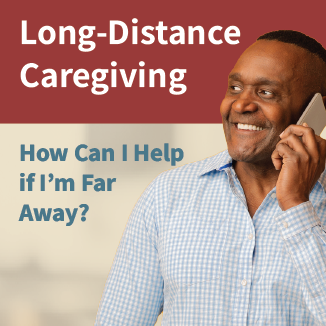Getting Started With Caregiving
If you have never been a caregiver before, it may feel daunting at first. There might be tasks to organize, new medical terms to learn, and schedules to coordinate. If you live far away from the person who needs care, you may need to find new ways to stay in touch. This article can help you figure out where to start as a caregiver.
What is caregiving?
Caregiving involves helping another person with everyday activities and tasks. Many caregivers are family members, friends, or neighbors. The kinds of activities that a caregiver may assist with include:
- Personal care, such as dressing, bathing, grooming, using the toilet, and brushing teeth
- Household tasks, such as shopping, laundry, and cleaning
- Preparing food, feeding, and monitoring dietary restrictions
- Health care, including talking to doctors, coordinating medical appointments, and keeping track of medications
- Transportation, such as car rides to appointments
- Financial and legal matters, such as paying bills and organizing important documents
-

The Caregiver’s Handbook
Explore this guide to getting started with caregiving, finding support, and taking care of yourself.
New to caregiving? Here’s what to do first
Caregiving can be overwhelming, especially at the beginning. Try to tackle one task at a time. The following offers some ways to get started.
Find out as much as you can about the person’s medical situation
Learn about the person’s health and any treatments they are receiving. Knowing the details of their situation can help you understand what is going on, anticipate how an illness might change or worsen over time, and manage the person’s health care. It can also make talking with the person’s doctors easier and reduce the likelihood of a medical crisis.
The older person may be hesitant to share their health information. They may not want to worry you, or they may not want others to know how serious their health issues have become. Approach these conversations sensitively and explain why you’re asking questions about their health.
If the person isn’t comfortable talking about it themselves, they may be willing for you to talk with their health care provider instead. By law, you will need written permission to receive medical information about the person unless they are with you in person and able to give consent. The health care provider’s office can explain the process and provide the necessary forms.
Determine where to get help
Consider asking family members and friends to share caregiving tasks. Read more about sharing caregiving responsibilities with family members.
If someone you know and trust is also a caregiver, ask them for tips and recommendations for resources near you. You can also look for resources online or in your community, such as local and state offices on aging, social service agencies, or nearby senior centers.
The Eldercare Locator can help you find resources in your area, including in-home help, transportation, and modifications to make a person’s home safer and easier to get around. It can also provide information about paying for care. Visit the Eldercare Locator or call 800-677-1116.
Get training if needed
Many people don’t have caregiving experience when they are first needed. Caregiver training is available from many sources, including hospitals, state and local governments, and nonprofit organizations. Training courses are often free or low-cost, and some can be completed online. Medicare and Medicaid, which are government insurance programs, will sometimes pay for caregiver training.
You can also review these worksheets to help you coordinate care and keep track of your caregiving responsibilities and needs.
How can you help with caregiving when you live far away?
Many people live far away from their family or friends who need help. If you don’t live nearby, you can still provide support and assistance as a long-distance caregiver.
These are a few ways to begin:
- Ask the person receiving care and the primary caregiver, if there is one, how you can be most helpful.
- Talk to people you know who are long-distance caregivers to see if they have suggestions about ways to help.
- Find out more about available resources in the older person’s community. For suggestions, search the Eldercare Locator or call 800-677-1116.
- Develop a good understanding of the person’s health issues and other care needs.
- Offer to provide occasional respite care to give the primary caregiver a break.
- When you visit, look for tasks that need to be done and can be taken care of from a distance.
Find more information about long-distance caregiving, including how you can help, ways to stay in touch, and resources for caregivers who live far away.
You may also be interested in
- Learning the signs that an aging parent needs help
- Finding services for older adults living at home
- Reading frequently asked questions about caregiving
Signup for e-alerts about caregiving tips and resources
For more information about getting started with caregiving
Eldercare Locator
800-677-1116
eldercarelocator@USAging.org
https://eldercare.acl.gov
Caregiver Action Network
202-454-3970
info@caregiveraction.org
www.caregiveraction.org
Family Caregiver Alliance
800-445-8106
info@caregiver.org
www.caregiver.org
This content is provided by the NIH National Institute on Aging (NIA). NIA scientists and other experts review this content to ensure it is accurate and up to date.
Content reviewed:
October 12, 2023




